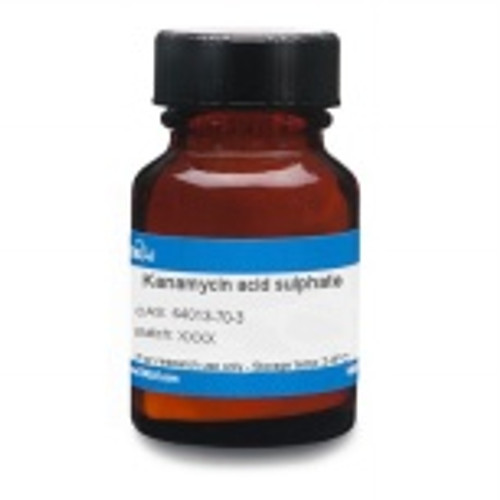Kanamycin A Sulfate, EvoPure is the highly purified sulfate salt form of Kanamycin A. Kanamycin A is the major component of the Kanamycin complex, with minor components of Kanamycin B and C.
Kanamycin is a semi-synthetic, broad-spectrum aminoglycoside antibiotic. Kanamycin was isolated from the soil bacterium Streptomyces kanamyceticus in 1957 by Hamao Umezawa at the institute of Microbial Chemistry (Tokyo). Kanamycin inhibits protein synthesis in bacteria and Mycoplasma. It is used to select for transformants (bacteria, fungi, plant, mammalian) which have been successfully transformed with a plasmid containing a kanamycin resistance gene.
Kanamycin A Sulfate, EvoPure is freely soluble in water. It is practically insoluble in ethanol, DMSO, acetone, chloroform, ether and ethyl acetate.
We also offer:
Kanamycin EvoPure® products are available as highly purified fractions (see Technical Data). Each compound is fully characterized by spectral analysis and a comprehensive C of A is provided which includes HPLC, MS, HNMR and FTIR data.
| Mechanism of Action | Aminoglycosides target the 30S ribosomal subunit, lodging between the 16S rRNA and S12 protein. This interferes with the translational initiation complex causing misreading of the mRNA, and production of a faulty or nonexistent protein. |
| Spectrum | Kanamycin is a broad-spectrum antibiotic, however, it is mostly used against aerobic Gram-negative bacteria. |
| Microbiology Applications | Kanamycin Sulfate is commonly used as a selective agent to select for resistant mammalian, fungal, or bacterial cells that contain the kanMX marker or other kanamycin resistance genes. Kanamycin Sulfate is typically used at a working concentration of 30-100 µg/mL.
Kanamycin can be used as a selective agent in several types of isolation media: Kanamycin Aesculin Azide Agar - Isolation of group D streptococci, isolation of Enterococci from food samples. Perfringens Agar - SFP and TSC selective supplements for the isolation of Clostridium perfringens Kanamycin Sulfate is commonly used for in vitro microbiological antimicrobial susceptibility tests (panels, discs, and MIC strips) against Gram-positive and Gram-negative microbial isolates. Medical microbiologists use AST results to recommend antibiotic treatment options. For additional MIC data for Kanamycin Sulfate, visit our Antimicrobial Index. |
| Plant Biology Applications | Kanamycin is often used in the Agrobacterium-mediated transformation using the neomycin phosphotransferase gene (npt II gene) as a selection marker which confers resistance to Kanamycin (and G418).
Gene transfer to cereal cells (Triticum monococcum) mediated by protoplast transformation with naked DNA. Plasmid contained a gene of interest along with the ntp II gene and after insertion, and transformed cells were selected on medium containing Kanamycin (Lorz et al 1985). In a study of drought and salt tolerance, soybeans (DT84 cultivar) were genetically modified using Agrobacterium-mediated transformation to insert the GmDREB6 gene along with the nptII gene to select for plants resistant to Kanamycin. GmDREB6 is a dehydration-responsive element binding proteins (DREBs), a plant transcription factor that binds to specific region of promoter to activate expression of mechanisms to cope with cellular dehydration. Overexpression of GmDREB6 increased transcription levels of GmP5CS which caused a higher intracellular proline content in plants growing under salt stress (Nguyen et al, 2019). |
| Molecular Formula | C18H36N4O11 · xH2SO4 (lot specific) |
| References |
Pryjma et al used Kanamycin Sulfate (TOKU-E) to select for transformed, Kanamycin-resistant Campylobacter jejuni cells: FdhTU-modulated formate dehydrogenase expression and electron donor availability enhance recovery of Campylobacter jejuni following host cell infection. Aragão FJL and Brasileiro ACM (2009) Positive, negative and marker-free strategies for transgenic plant selection. Braz. J. Plant Physiol. 14(1):1-10 Davis BD (1987) Mechanism of bactericidal action of aminoglycosides. Microbiol. Rev. 51(3):341-350 Grant CCR, Konkel ME, Cieplak Jr W, and Tompkins LS (1993) Role of flagella in adherence, internalization, and translocation of Campylobacter jejuni in nonpolarized and polarized epithelial cell cultures. Infect. and Immun. 61(5):1764-1771 PMID Kaur P and Bansal KC (2010) Efficient production of transgenic tomatoes via Agrobacterium-mediated transformation. Biol. Plant. 54 (2): 344-348 Lorz H, Baker B and Schell J (1985) Gene transfer to cereal cells mediated by protoplast transformation. Molec. and Gen. Genetics 199:178-182 Nguyen QH et al (2019) Overexpression of the GmDREB6 gene enhances proline accumulatin and salt tolerance in genetically modified soybean plants. Sci Rep. 9:19663 PMID 31873128 Sharma MK, Solanke AU, Jani D, Singh Y and Sharma Ak (2009) A simple and efficient Agrobacterium-mediated procedure for transformation of tomato. J. Biosci. 34(3): 423–433 Sneader W (2005) Drug Discovery: A history. John Wiley & Sons pp 302 Takahashi T, Morotomi Ma nd Nomoto K (2004) A novel mouse model of rectal cancer established by orthotopic implantation of colon cancer cells. Cancer Sci. 95(6):514-519 PMID 15182433 |
| MIC | Enterobacter cloacae (ATCC 3047)| 8|| Enterococcus faecium (119)| 64|| Escherichia coli| 4 - 2000|| Pseudomonas aeruginosa| 32 - 1000|| Salmonella Enteritidis| 50|| Salmonella Gallinarum| 50|| Salmonella typhi| 50|| Serratia marcescens| 8|| Shigella flexneri| 10|| Staphylococcus aureus| 4 - 50|| Vibrio cholerae| 50|| |








